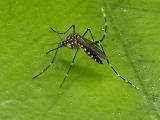With the first case of yellow fever (YF) confirmed late last week in the Rio de Janeiro metro area and cases in several Brazilian states spreading closer to cities, an official from the country's ministry of health says authorities are prepared for a potential explosion of the virus in Brazil's densely populated urban centers, but much of the population lacks coverage.
A 61-year-old man in Marica, which is about 30 miles east of downtown Rio, died on Apr 19, and the state health department confirmed that he had contracted the mosquito-borne disease, the Rio newspaper O Globo reported on Apr 20.
His is the 11th case in the state of Rio de Janeiro and the third death, the story said.
All of Rio targeted for vaccine
In interviews with CIDRAP News, Akira Homma, MD, a senior scientific adviser at Bio-Manguinhos, Fiocruz, which is responsible for developing and producing vaccines in Brazil, said the country is currently able to keep up with demand for YF vaccine. Brazil is the only country in South America to manufacture the vaccine.
Homma said the routine demand of YF vaccine is around 15 million doses yearly, but because of the current outbreak, an additional 52 million doses are needed by the end of 2017. Homma said that it takes 40 to 50 days to produce the YF vaccine, but, Bio-Manguinhos had already obtained enough active pharmaceutical ingredients for more than 50 million doses. He said it was possible to formulate the vaccine in 21 to 22 days.
"We have already supplied 24 million doses as of now," said Homma via e-mail. "The plan is to vaccinate the entire population of Rio de Janeiro city by the end of the year." Rio is Brazil's second-largest city, with 6.3 million people (Sao Paulo has double that amount). Recent epizootic cases near the urban area suggest that human transmission may be inevitable.
"[The] Brazilian National Immunization Program has discussed a lot with the states and municipalities health authorities and reached a scheduled to immunize all the people located in the expanded risk areas," Homma explained. "The priority for vaccination is the people living closer to the places or regions where YF cases or monkeys died by YF infection."
Homma said last year's YF outbreak in Angola and the Democratic Republic of the Congo proved that using fractional dosing can be an appropriate way to stretch vaccine supplies in an emergency.
"If a YF case happen[s] to occur today, there is plan to utilize the fractionated dosage of vaccine," said Homma. "Instead of a full dose [of] 0.5 ml [milliliter], a dose of 0.1 ml will be used. This dosage was used recently in Africa with success."
For now, Homma said vaccination efforts are under control. Earlier last week, the country's Ministry of Health (MoH) added the entire state of Rio de Janeiro to the growing list of areas where YF vaccination is recommended prior to traveling.
Vaccination coverage spotty
Thomas Monath, MD, chief scientific and chief operating officer of BioProtection Systems/NewLink Genetics Corp, said the current YF outbreak in Brazil is the biggest jungle outbreak of the disease since the mid-1970s. Because the country has largely avoided YF outbreaks in the past 40 years, the vaccination coverage in the general population is spotty.
"The current outbreak shows that the population in the endemic areas are under vaccinated, and that's because Brazil has had a mixed-vaccination policy over the years," Monath said. He explained that at times the country has done both routine infant immunization and hosted catch-up campaigns for adults.
"That's inefficient," said Monath. "A lot of people were missed or get revaccinated unnecessarily." One dose of the YF vaccine confers lifelong immunity.
Moreover, some people in Sao Paulo suffered adverse effects from the vaccine during a mass vaccination campaign in 2000, Monath said. The scare made health authorities less aggressive in pushing the vaccine in urban areas.
For Monath, the biggest problem in Brazil has been that the nation has arbitrarily defined which parts of the country have endemic YF—and thus have populations requiring vaccination—and which parts are "safe."
"It's an artificial line between the endemic and coastal region," said Monath. "And that line has changed whenever there's a situation like this."
Homma said Monath was correct. "Due to the recent YF cases in the state of Minas Gerais, Espirito Santo, Rio de Janeiro and Sao Paulo, the MoH has expanded the area considered for YF immunization. And these expanded areas were also considered by the National Immunization Program," he said.
See also:
Apr 20 O Globo story





















